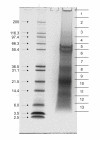In-depth, high-accuracy proteomics of sea urchin tooth organic matrix
- PMID: 19068105
- PMCID: PMC2614417
- DOI: 10.1186/1477-5956-6-33
In-depth, high-accuracy proteomics of sea urchin tooth organic matrix
Abstract
Background: The organic matrix contained in biominerals plays an important role in regulating mineralization and in determining biomineral properties. However, most components of biomineral matrices remain unknown at present. In sea urchin tooth, which is an important model for developmental biology and biomineralization, only few matrix components have been identified. The recent publication of the Strongylocentrotus purpuratus genome sequence rendered possible not only the identification of genes potentially coding for matrix proteins, but also the direct identification of proteins contained in matrices of skeletal elements by in-depth, high-accuracy proteomic analysis.
Results: We identified 138 proteins in the matrix of tooth powder. Only 56 of these proteins were previously identified in the matrices of test (shell) and spine. Among the novel components was an interesting group of five proteins containing alanine- and proline-rich neutral or basic motifs separated by acidic glycine-rich motifs. In addition, four of the five proteins contained either one or two predicted Kazal protease inhibitor domains. The major components of tooth matrix were however largely identical to the set of spicule matrix proteins and MSP130-related proteins identified in test (shell) and spine matrix. Comparison of the matrices of crushed teeth to intact teeth revealed a marked dilution of known intracrystalline matrix proteins and a concomitant increase in some intracellular proteins.
Conclusion: This report presents the most comprehensive list of sea urchin tooth matrix proteins available at present. The complex mixture of proteins identified may reflect many different aspects of the mineralization process. A comparison between intact tooth matrix, presumably containing odontoblast remnants, and crushed tooth matrix served to differentiate between matrix components and possible contributions of cellular remnants. Because LC-MS/MS-based methods directly measures peptides our results validate many predicted genes and confirm the existence of the corresponding proteins. Knowledge of the components of this model system may stimulate further experiments aiming at the elucidation of structure, function, and interaction of biomineral matrix components.
Figures



Similar articles
-
The sea urchin (Strongylocentrotus purpuratus) test and spine proteomes.Proteome Sci. 2008 Aug 11;6:22. doi: 10.1186/1477-5956-6-22. Proteome Sci. 2008. PMID: 18694502 Free PMC article.
-
Phosphoproteomes of Strongylocentrotus purpuratus shell and tooth matrix: identification of a major acidic sea urchin tooth phosphoprotein, phosphodontin.Proteome Sci. 2010 Feb 8;8(1):6. doi: 10.1186/1477-5956-8-6. Proteome Sci. 2010. PMID: 20181113 Free PMC article.
-
Proteomic analysis of sea urchin (Strongylocentrotus purpuratus) spicule matrix.Proteome Sci. 2010 Jun 17;8:33. doi: 10.1186/1477-5956-8-33. Proteome Sci. 2010. PMID: 20565753 Free PMC article.
-
Biomineral proteomics: A tool for multiple disciplinary studies.J Proteomics. 2021 Apr 30;238:104171. doi: 10.1016/j.jprot.2021.104171. Epub 2021 Feb 27. J Proteomics. 2021. PMID: 33652138 Review.
-
Identification and developmental expression of the ets gene family in the sea urchin (Strongylocentrotus purpuratus).Dev Biol. 2006 Dec 1;300(1):35-48. doi: 10.1016/j.ydbio.2006.08.012. Epub 2006 Aug 10. Dev Biol. 2006. PMID: 16997294 Review.
Cited by
-
Acorn worm ossicle ultrastructure and composition and the origin of the echinoderm skeleton.R Soc Open Sci. 2022 Sep 21;9(9):220773. doi: 10.1098/rsos.220773. eCollection 2022 Sep. R Soc Open Sci. 2022. PMID: 36147942 Free PMC article.
-
Proteomic analysis of total cellular proteins of human neutrophils.Proteome Sci. 2009 Aug 31;7:32. doi: 10.1186/1477-5956-7-32. Proteome Sci. 2009. PMID: 19719850 Free PMC article.
-
A therapeutic potential for marine skeletal proteins in bone regeneration.Mar Drugs. 2013 Apr 10;11(4):1203-20. doi: 10.3390/md11041203. Mar Drugs. 2013. PMID: 23574983 Free PMC article. Review.
-
Analysis of the proteinaceous components of the organic matrix of calcitic sclerites from the soft coral Sinularia sp.PLoS One. 2013;8(3):e58781. doi: 10.1371/journal.pone.0058781. Epub 2013 Mar 14. PLoS One. 2013. PMID: 23527022 Free PMC article.
-
Genomic insights of body plan transitions from bilateral to pentameral symmetry in Echinoderms.Commun Biol. 2020 Jul 10;3(1):371. doi: 10.1038/s42003-020-1091-1. Commun Biol. 2020. PMID: 32651448 Free PMC article.
References
-
- Märkel K, Röser U, Mackenstedt U, Klostermann M. Ultrastructural investigation of matrix-mediated biomineralization in echinoids. Zoomorphology. 1986;106:232–243. doi: 10.1007/BF00312044. - DOI
-
- Märkel K, Röser U, Stauber M. On the ultrastructure and the supposed function of the mineralizing matrix coat of sea urchins (Echinodermata, Echinoidea) Zoomorphology. 1989;109:79–87. doi: 10.1007/BF00312313. - DOI
-
- Märkel K, Gorny P. Zur funktionellen Anatomie der Seeigelzähne (Echinodermata, Echinoidea) Z Morph Tiere. 1973;75:223–242. doi: 10.1007/BF00401492. - DOI
-
- Märkel K, Gorny P, Abraham K. Microarchiteture of sea urchin teeth. Fortsch Zool. 1977;24:103–114.
LinkOut - more resources
Full Text Sources
Miscellaneous

